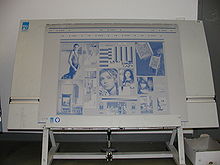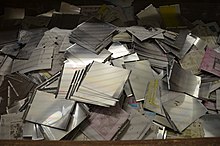printing plate
A printing plate is a print image memory for text and / or image information of all kinds. Printing plates are all flat, rigid or flexible printing forms for various printing processes .
Conventional printing plate types
Half of all plates produced worldwide are conventional printing plates. They are sensitive to UV light. There are negative and positive plates. The leading manufacturers include Agfa , Fujifilm and Kodak .
Manufacturing
High-purity aluminum (99.9%) is required for the production of aluminum printing plates. This is delivered on rolls several kilometers long. There are very few aluminum suppliers who meet the high demands of the graphic industry (dimensional accuracy, freedom from dust, purity of the material). This is why almost all printing plate manufacturers get their aluminum from the same suppliers.
The printing plates have an electrochemical and electrolytic surface which is anodized and then provided with the photosensitive layer in a proprietary process. This is followed by a drying process, as the freshly applied layer is extremely sensitive to scratches. Finally, the printing plates are cut from the tape product into piece goods using the shear cut principle and placed in the packing line. There the panels are cut to the final format with a plan cutter using the knife cut principle and then packaged. To protect against undesired incorrect exposure, the entire processing process is located in darkened halls with yellow light.
Printing plate types for CTP systems (Computer to Plate)
Photopolymer plate
- Light sensitive between 400 and 550 nm
- Low laser energy of 100 to 200 µJ / cm 2 required for exposure
- Print run length of the printing plates up to 500,000 prints (when the printing plates are burned in, around 1,000,000 prints)
- Photopolymer plates are increasingly used in the artistic field for the production of etchings ( non-toxic printmaking , intaglioprint ). The resulting polymer relief is colored and printed as a gravure print.
Silver halide plate
Silver halide aluminum printing plates
- Sensitive to light in the wavelength range 400 to 700 nm
- Low laser energy of 1 to 2 µJ / cm 2 required for exposure
- Print run length of the printing plates up to 350,000 prints
- A grid width down to 120 lines per centimeter is possible
- Tonal range from 1–99%
- High process stability is only possible if very narrow process parameters are adhered to
- Processing in daylight-like yellow light possible
- Few providers
Polymer plate
- Light sensitive between 830 and 1,070 nm
- High laser energy of up to 500 mJ / cm 2 required for exposure
- Print run length of the printing plates up to 100,000 prints (when the printing plates are burned in, around 1,000,000 prints)
- A grid width of around 150 lines per centimeter is possible
- Tonal range from 1–99%
- Relatively high process stability
- Processing in daylight possible
- Some providers
- Very high surface sensitivity, therefore processing only with gloves
Ablation plate
The latest generation of printing plates no longer needs developing machines; the exposed layer is suctioned off directly during exposure, the minimal remaining fine dust is cleaned from the printing plate in the printing machine via the dampening unit. This type of printing plate requires less water and has a faster ink / water balance. The high price has a negative effect, so that a cost reduction due to the unneeded development machines or developers, gumming, personnel deployment, etc. can only be spoken of in the specifically considered individual case. With the same resolution, support stability and faster freewheeling behavior, the ablation plate is more sensitive in handling; Incorrect water additive or printing plate cleaner (with abrasive) as well as careless transport quickly destroy the sensitive layer.
See also
Web links
- Photopolymer plates (nyloprint) in letterpress printing. ( Memento from February 10, 2013 in the web archive archive.today ) Introduction and instructions for the production of polymer printing plates at: druckhandwerk.de




